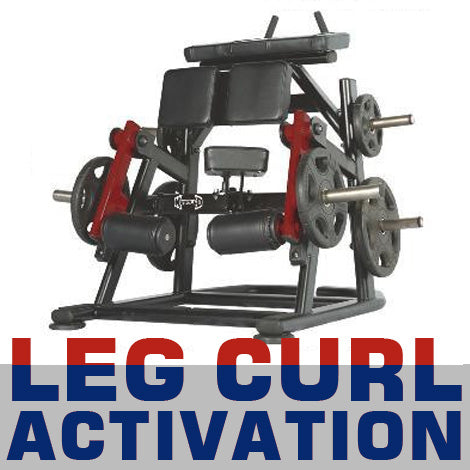BFS Athletes Need Leg Curls

The BFS program emphasizes free weights over machines, but there are some exercises performed with machines that are especially valuable for athletic and physical fitness programs. One such exercise that BFS has been promoting for nearly four decades is the leg curl.
Leg curl machines are a key fixture in commercial gyms, and they are one of the first machines purchased for high school and college weight rooms. Its popularity is such that BFS offers both an economical plate-loaded leg curl machine, along with selectorized leg curl machines, and even ones that combine both exercises in one unit for those gyms where space is especially limited.
Leg curls are one of the best exercises to strengthen the hamstrings, but to fully appreciate their value, you need a flash course in biomechanics. The hamstrings are not a single muscle but several that collectively perform the following functions: flex the knee, extend the hips, and rotate the foot inward or outward. Leg curls focus on the muscles that flex the knee; in contrast, a straight leg deadlift focuses on the muscles that extend the hip. The glute-ham raise, a BFS auxiliary exercise that is performed on a glute-ham developer, works both hip flexion and knee flexion.
Whereas the quads are involved in generating force while jumping and propel the body at the start of a sprint, the hamstrings are most strongly involved in deceleration. Have doubts? Find a steep hill about 30 yards long, walk up it, and run down; repeat about 8-10 times. The next day you might find it difficult to sit as your hamstrings will be so sore. Likewise, if you were to sprint up that same hill and walk down it 8-10 times, the next day your quads will probably be sore.
During sprinting, the quads will be used more at the start and the hamstrings will start kicking in when the body transitions to the upright sprinting posture.
The Dog Sled has reversible vertical handles, and the BFS Heavy Duty Push/Pull Sled has vertical and horizontal handles. The lower the grip on the handles, the greater the involvement of the quads and less involvement of the hamstrings. This is a valuable benefit for those recovering from a hamstring injury.
If a sprinter pulls a hamstring, because there is little eccentric overload in pushing a sled, after the initial stages of rehab a sprinter could start walking, running, and then sprinting with a sled. BFS Editor Kim Goss worked with a high school sprinter who suffered a Grade 1 level hamstring pull, and at the time the sports medicine physician predicted it might take her up to five months to completely recover. Within six weeks when was breaking personal records in the 100m and 200m sprinters.
The two most popular types of leg curl machines found in most commercial gyms and strength and conditioning facilities are prone and seated. It’s been said that the seated leg curl machine was developed for those with lower back issues that made lying face down uncomfortable, or for women who are pregnant and as such have to avoid lying face down.
The problem with seated leg curl machines is that we’ve found they tend to cause hyperextension of the knee, especially when performed with heavy weights. BFS has a line of machines for kids that seated leg curl (in combination with a leg extension), but it’s a hydraulic unit so that resistance is provided only when leg muscle shortens so that they are less risk of hyperextension. However, because running involves strong
eccentric (i.e., muscle lengthening) contractions, physically mature athletes should focus on leg curls that provide resistance for both eccentric and concentric contractions to ensure full
development.
Depending upon your budget, BFS offers the economical plate-loaded prone leg curl along with a selectorized version. For those facilities tight on space, we have a combination leg extension/leg curl machine that enables the user to change from a seated leg extension to a prone curl in a matter of seconds by simply folding down a backrest.
The two types of rotation of the foot are lateral rotation, turning the feet away from the body, and medial rotation, turning the feet inward. If an athlete presents a muscle imbalance that causes them the walk with their knees pointed excessively inward, they should perform leg curls with the feet turned outward. Likewise, if they walk with their feet turned excessively outward, they would perform leg curls with their feet turned inward. If there is no imbalance, the feet should remain in a neutral position. Although the leg curl seems like a simple movement, there are ways to make it more challenging, thus creating a higher level of muscle tension on the hamstrings.
Many strength coaches believe it’s best to start the exercise with your toes pulled towards the body as you lift the weight and then point them away from the body as you lower the weight. Here’s the thinking. Because the gastrocnemius (upper calf muscle) assists the hamstring when the toes are pulled back, you can lift more weight, thus increasing muscle tension. And because you can lower more weight than you can lift, you would point the toes away from you to isolate the hamstrings and, again, increase the muscle tension. And to brutally blast the hamstrings, try raising the weight with both legs and lowering it with one leg; perform the same reps with both legs.
Although the hamstrings do contain slow-twitch muscle fibers that respond better to higher repetitions, athletes should emphasize lower reps so they can use heavier weights. This is because a high level of muscle tension is needed to effectively deal with sudden stops and changes in direction when athletes move at high speeds. In fact, because an estimated 70 percent of ACL injuries are non-contact, it makes sense that the hamstrings should be trained with workouts that create a high level of muscle tension to simulate the actions that occur in athletes.
The value of working the hamstrings at a high level of muscle tension was demonstrated in a study on Danish soccer players published in 2012 in the Journal of Physiotherapy. The study involved 942 athletes, divided into a group that did a hamstring exercise for 10 weeks and a control group that did not perform the exercise. At the end of the season, the group that did not perform the exercise suffered 52 injuries whereas the group that performed the exercise only reported 15 injuries!
BFS offers three types of prone leg curl machine. The first is a plate-loaded version, which is ideal for programs on a tight budget because it does not contain a weight stack. Then we have two selectorized units, one that has the user performing the exercise as a stand-alone unit and one that enables the user to perform a quadriceps exercise. This combination machine has an ingenious design that enables you to convert the leg curl function into a leg extension machine in a manner of seconds – such a feature makes it perfect for circuit training. This unit, called the “Selector – Leg Curl and Extension,” is also the answer for facilities that are short on space.
With over 40 years in the business, BFS has found that free weights should be the focus of any workout designed to improve physical and athletic fitness. However, we’ve also found that there are some machines that should be added to your program because of their effect on improving athletic performance. The leg curl is one such exercise.

